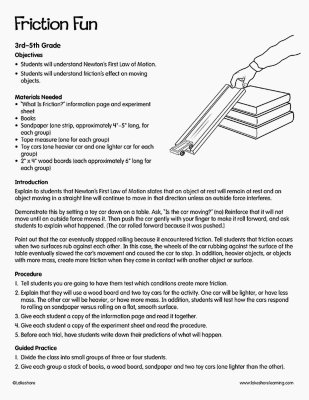Narrow by Grade
- Infant (0)
- Toddler (0)
- Preschool (0)
- Pre-K (0)
- Kindergarten (0)
- 1st (0)
- 2nd (0)
- 3rd (1)
- 4th (2)
- 5th (0)
- 6th & Up (0)
Grade
Narrow by Age
- 0-18m (3)
- 18-36m (4)
- 3 yrs. (0)
- 4 yrs. (6)
- 5 yrs. (8)
- 6 yrs. (4)
- 7 yrs. (4)
- 8 yrs. (2)
- 9 yrs. (2)
- 10 yrs. (3)
- 11 yrs. & Up (0)
Age 9 yrs.
2 results for "super fun marble run"
Filters
Clear All
Friction Fun
4th Grade
Objectives Students will understand Newton’s First Law of Motion. Students will understand friction’s effect on moving objects. Materials Needed “What Is Friction?” information page and experiment sheet Books Sandpaper (one strip, approximately 4" - 5" long, for each group) Tape measure (one for each group) Toy cars (one heavier car and one lighter car for each group) 2" x 4" wood boards (each approximately 6" long for each group) Introduction Explain to students that Newton’s First Law of Motion states that an object at rest will remain at rest and an object moving in a straight line will continue to move in that direction unless an outside force interferes. Demonstrate this by setting a toy car down on a table. Ask, “Is the car moving?” (no) Reinforce that it will not move until an outside force moves it. Then push the car gently with your finger to make it roll forward, and ask students to explain what happened. (The car rolled forward because it was pushed.) Point out that the car eventually stopped rolling because it encountered friction. Tell students that friction occurs when two surfaces rub against each other. In this case, the wheels of the car rubbing against the surface of the table eventually slowed the car’s movement and caused the car to stop. In addition, heavier objects, or objects with more mass, create more friction when they come in contact with another object or surface.
View Lesson PlanMy Awesome, Amazing, Very Good, Super-Great Day Story
3rd Grade - 4th Grade
Objectives Students will listen to, recall and interpret information from literature. Students will make connections to their personal experiences. Students will write a descriptive paragraph. Materials Needed Alexander and the Terrible, Horrible, No Good, Very Bad Day by Judith Viorst Graphic organizer Revising and Editing checklist Introduction Read aloud Alexander and the Terrible, Horrible, No Good, Very Bad Day to your class. After you read, ask students to recall the things that happened to Alexander that added to his terrible, horrible, no good, very bad day. Then ask students to think about what could have happened differently to turn Alexander’s day into an awesome, amazing, very good, super-great day. Invite volunteers to share their responses.
View Lesson Plan
